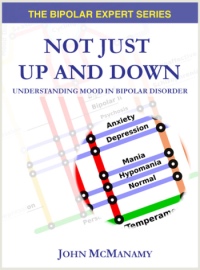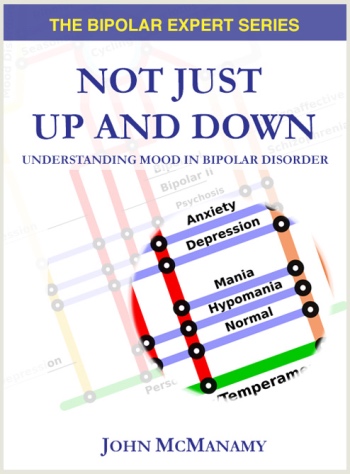Doing Recovery
 |
Everyone is talking about recovery. These people are actually DOING it.
|
Recovery in mental health. A police car rolls up to the back door of a psychiatric urgent care facility. A three-person team comprising a doctor, a nurse, and a peer specialist scramble to the parking lot to greet their new arrival.
"Jack” is in the back, frightened and disoriented. He is in restraints. An hour before, someone made a 911 call, the type we read about in the papers all the time, especially when things go wrong.
Thankfully, so far, things have gone right. Thanks to an outreach by the organization that runs the facility, the local police have CIT (crisis intervention team) units on every watch. These are officers specially trained in dealing with situations involving the mentally ill. They have talked Jack into accepting his restraints and into getting into the car with minimal fuss. On the ride over, the officers have assured Jack that he is not going to jail.
My New Book!

Purchase now.
Jack is out of the car. After a quick conversation with the doctor, the police remove Jack’s restraints. The doctor has assumed full responsibility for anything that may go wrong, but nothing does. Jack is relieved to be out of his restraints, and almost instantly calms down. The staff escort Jack into the facility, and very soon the police are on their way.
Once inside the building, Jack displays signs of acting up, but no huge orderlies materialize, primed for the “takedown.” Instead, Jack is allowed to go out to the patio to have a smoke. The peer specialist assures Jack he will not be violated. There is zero seclusion and restraint at the facility. The “butt shot” - chemical restraint - is a last resort and only rarely used, three times out of more than 500 people in the last month.
“I know how you’re feeling,” the peer specialist tells Jack. “I was once in here as a patient, myself.”
By now, the clinical staff is involved in the conversation. There are no threats or implied threats. “Engagement” is taking place. The stabilization phase of working with a patient is beginning, but recovery is also in the air.
Changing the Culture
The urgent care facility (the front door says Psychiatric Recovery Center} is run by Phoenix-based Recovery Innovations (RI). In its earlier incarnation as META, RI had been operating successfully as a traditional behavioral health organization for about 10 years Then, in 1999, its CEO Eugene Johnson had what he described as a “crisis of conscience.”
At a two-day workshop RI hosted in late 2007 in Phoenix, Mr Johnson recounted a conference he attended. There, he heard patients talk about how discouraging it was to be continually written off and disenfranchised and disrespected by the very people who were supposed to be helping them.
As he describes it, suddenly he realized the patients were talking about him.
This strikes a nerve with one of the workshop participants. She has a PhD and works for a mental health advocacy organization. She tells the group about how, during one of her five hospitalizations, she attempted with no success to get staff to listen to her concerns about her cat, left home alone.
Their response was to swarm her and put her in restraints.
Mr Johnson came back from his conference determined to turn things around. His first edict was a ban on seclusion and restraints. This was a tall order, as 40 percent of the 1,200 patients its two centers saw every month were brought in involuntarily. Staff also feared for their own safety, which in Mr Johnson’s mind was precisely the reason for turning the organization on its head - clinical decisions were being made based on the staffers’ anxiety, not on what was best for the patient.
As Lori Ashcraft PhD, executive director of RI, explained in so many words, when staff fear meets patient fear, generally good things do not happen.
To their credit, the staff were willing to give zero restraints a try. After 15 months at the smaller crisis center and 41 months at the larger one, zero restraint became a reality. The medical staff credited the peer specialists for their skills in “de-escalation and engagement.”
Later, over medical staff objections, RI set up an unlocked “living room,” run by peer specialists. In the first month of operation, something funny began to happen. Referrals for hospitalization dropped from 16 a month to six, a figure that has held steady ever since.
RI speculates that whereas medical staff tend to focus almost exclusively on a person’s problems, peers were engaging their “guests” in conversations about recovery. What goes on in those crucial first minutes and hours and days, they say, can have a profound long-term impact.
No Slipping Through the Cracks
A van drops us off at a small housing block. I’m wondering why I’m here, basically looking at a bunch of bricks and mortar, when someone explains:
Imagine Jack, back at the crisis center. Thanks to peer staff, he has participated in his own “exit plan.” Maybe he is even thinking about his own recovery. He has a list of appointments that will hook him into various services, plus some offered by RI. The catch is if Jack is living on the streets, he is not likely to make those appointments.
Temporary housing is RI’s answer to the prospect of losing Jack to the streets. RI is already at work with the appropriate agencies, getting him placed in a situation more permanent. In the meantime, Jack has access to the peer recovery coaches on the premises.
I’m learning. Recovery is all about having all the pieces of the puzzle in place.
Education is Vital
The centerpiece of RI’s operations is housed in a modern office building. The atmosphere is spotless, but not a clinical sense. If there are any medical staff, RI has them hidden away in a broom closet. These facilities are for administration and education.
During a break in the workshop I’m attending, I walk down the corridors. Clusters of people are informally gathered in various alcoves and rooms. In other rooms, more formal conversations are talking place. There is no sense in trying to distinguish patients from staff. In most instances, patients ARE staff. Of RI’s more than 300 employees, about two-thirds are patients. A lot of these are part-timers, but by now I have gotten the message: RI, from crisis to recovery, runs on patient power.
In one classroom I spot new computers. This contrasts sharply with a drop-in center I visited in northern CA only a year before., There, in a back room, vintage PCs - unconnected and unplugged - gathered dust. Drop-in center was a misnomer. Drop-out center was more like it.
Someone informs me that numbers were surprisingly small for the first computer classes. Then RI wised up and began offering keyboard classes.
Some 300 students at any one time participate in a range of curriculum offerings, from basic Recovery 101 type of classes (including WRAP) to earning credits for an associates degree (in partnership with the local community college) to learning work force skills.
It is in these classrooms that RI incubates its own growth. An 80-hour offering hatches peer specialists, many who will be employed in this capacity by RI and elsewhere. These are the people RI credits with transforming the culture of the organization. I get an opportunity to talk to some of the students doing the peer training. I want to know what turned their lives around. How, in essence, did they progress from a feeling of helplessness and low self-worth to thinking they could do something with their lives?
To a person, they reply that it’s the presence of peer staff, fellow patients. These are individuals they can relate to. Their lived wisdom carries huge credibility. I keep hearing them say things along the lines of, if he or she could do it then so can I.
Yes, but what about someone like Jack?
By now, you are getting it. These people ARE Jack.
Yes, But ...
The 11 other people doing the workshop with me all happen to be from California. There, clinicians and administrators talk very loudly about recovery and transformation, but hardly anyone is actually doing it.
As the result of a voter initiative in California back in 2003, special funding was been set aside for mental health transformation, but embarrassed state officials, sitting on billions of dollars, had no idea how to spend it. Meanwhile, vital services were being cut.
Certainly, no one is talking about training and hiring patients en masse and putting them to work side-by-side with medical staff and social workers and educators.
The people I am with are an enlightened group. Nearly all are involved in some form of therapy services, some in supervising positions. They want change. They are serious about making recovery happen, but their questions are very different than mine. They will be going back to very skeptical directors and bureaucrats.
Is this particular service reimbursable under Medicaid? is typical of what they need to know. Where do providers like Magellan fit in? How do you satisfy various county and state requirements?
And numbers. They want numbers. Numbers that show, say, steep reductions in patients on housing subsidies or their need for crisis services. RI has these and others. Boston University’s Center for Psychiatric Rehabilitation, which is performing a series of outcome studies, is bound to come up with more.
This isn’t rocket science, the woman sitting next to me lets me know. She’s the one who, during one of her hospitalizations, got taken down and restrained for asking about her cat. Her PhD is in industrial organizational psychology. She is intimately familiar with the dynamics of institutional resistance to change. She knows how people in secure positions feel threatened by the prospect of innovation. She knows how professionals tend to act worse than patients at their worst when their authority is challenged.
But we both acknowledge there is also another dynamic in play: Any good idea, anything that works, always gets stolen. RI is an apple waiting to be plucked, overdue for the equivalent of a Bill Gates to appropriate and propagate. Any takers?
Just What Is Recovery, Anyway?
In Dec 2004, SAMSHA convened a consensus conference involving 110 panelists that included patients and family members, plus clinicians and administrators and other experts. In March 2006, the agency issued its “Consensus Statement on Mental Health Recovery” that includes this definition:
“Mental health recovery is a journey of healing and transformation enabling a person with a mental health problem to live a meaningful life in a community of his or her choice while striving to achieve his or her full potential.”
The Consensus Statement also lists “10 Fundamental Components”:
- Self-Direction: “Consumers lead, control, exercise choice over, and determine their own path of recovery ... “
- Individualized and Person-Centered: “There are multiple pathways to recovery based on an individual’s unique strengths and resiliencies as well as his or her needs [and] preferences ...”
- Empowerment: “Consumers have the authority to choose from a range of options and to participate in all decisions ...”
- Holistic: “Recovery encompasses an individual’s whole life ...”
- Non-Linear: “Recovery is not a step-by-step process but one based on continual growth, occasional setbacks, and learning from experience ...”
- Strengths-Based: “Recovery focuses on valuing and building on the multiple capacities, resiliencies, talents, coping abilities, and inherent worth of individuals ...”
- Peer Support: “Mutual support—including the sharing of experiential knowledge and skills and social learning—plays an invaluable role in recovery ...”
- Respect: “Community, systems, and societal acceptance and appreciation of consumers - including protecting their rights and eliminating discrimination and stigma - are crucial in achieving recovery ...”
- Responsibility: “Consumers have a personal responsibility for their own self-care and journeys of recovery ...”
- Hope: “Recovery provides the essential and motivating message of a better future - that people can and do overcome the barriers and obstacles that confront them.”
Note
"Jack" is a scenario based on my interviews with RI staff. I did not witness an actual intake to the crisis unit.
Feb 10, 2008, reviewed Jan 2, 2011
 |
More articles on recovery. |




